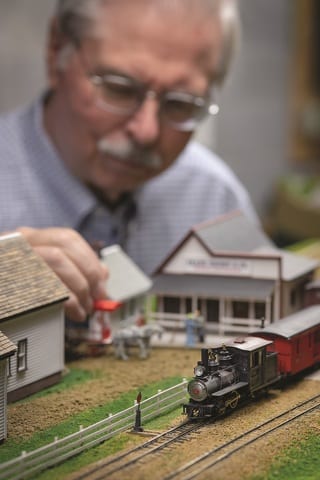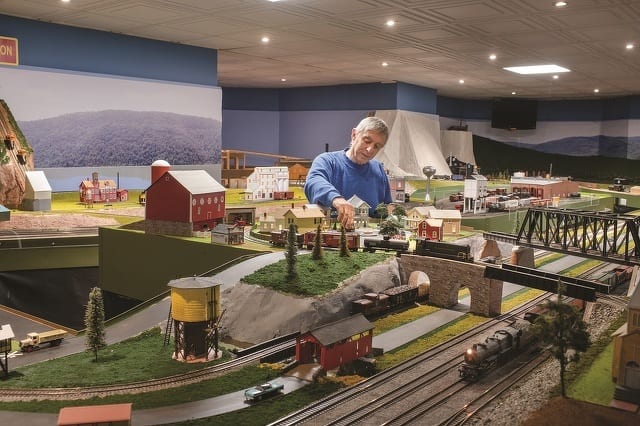Above a sizable outbuilding behind Tom Vaughn’s property in Curtin is a whole world that, driving by, you’d never suspect was there.
Climbing the stairs from the building’s first level, where the Vaughns store equipment and tools typical of an outdoor shed, you’re met with a surprising scene: a miniature railroad and corresponding landscape take up the entire room, making the space feel like an old-time department store at Christmastime.
Lee Rainey has two layouts in his Ferguson Township home. One is what he calls his “permanent layout,” set in 1950s central Pennsylvania; the other is his “traveling layout,” set in Maine in 1908, that he and his wife, Virginia, take to train shows across the country.
In Joel Williams’ basement in Lock Haven, too, a railroad layout consumes nearly the entire square-footage. The display includes an idyllic little town and neighborhoods, varying terrain, and geographical curiosities.
“It’s kind of like a closet hobby,” says Vaughn. “You don’t know who has them. There could be one three doors down on your block, and you don’t know.”
An ageless hobby
Vaughn says he, like many fellow model train enthusiasts, got his start in the pastime as a kid. In fact, he has on display in his layout room the first toy train he was ever gifted; he received it on his second birthday.
“It’s a typical story, if you look at any train magazine, [people] got trains when they were a teen, they ran the trains, then along came education and family and kids, and they were put away, then they got them out a little bit around Christmas,” Vaughn says. “I did the same thing. I had a layout in the house for a while, but this is the biggest one I’ve ever had.”
“I got my first electric train when I was 3 years old,” says Rainey. “I was told that I was interested in trains before that.”
Williams says when he was a kid, he and his friends would be outside playing ball, watching locomotives at the local railroad – generally being active.
“I’ve been interested in railroads since my mother took me down to the railroad near where we lived at 3 years old,” says Williams.
Today, Williams spends a lot of time fine-tuning and enhancing his layout. His club, The Susquehanna S Gaugers, wants more young people to get involved. In November, the club held a drawing at the Will Huffman Toy Train Expo in Williamsport to give away a free train set to a child.
“We’re trying to promote trains among the younger crowd,” Williams said. “These days, kids seem to be more interested in [being on their cellphones]. Everybody when I was growing up had a train under their Christmas tree. Now you never see that.”
Rainey says he encourages young people to incorporate modern interests into the old-fashioned hobby.
“Many youngsters nowadays are interested in computer games,” says Rainey. “I would say model railroading is a subset of that interest, because there are many applications for computers in model railroading. It’s everything that you can do with a computer game and more.”
Jarrod Little of Morrisdale is something of an anomaly in the model train world. He’s only 34, but got his start in trains the same way as the previous generation. He’s been interested in them since he was 4 years old and his grandfather would take him to watch trains run by his house. Because they’re so far away, Little isn’t a part of any club, but he tries to share his layout with the public around Christmas.

Tom and Donna Vaughn attend train expos together. Photo by Darren Andrew Weimert.
Multiple aspects, endless details
Williams says some of the best guidance anyone ever gave him was, “If you get tired of doing something, there’s plenty of other things to do.”
In the model-train world, depending on the intricacy of a person’s layout and the depths of an enthusiast’s budget, the possibilities of “doing other things” are nearly endless. Model trains combine aspects of engineering, electronics, logistics, history, geology and geography, and, some would argue, art.
“I think it’s neat how you can see the different talents you have, from electrical, carpentry, and artistic talents,” Little says.
Williams’ layout contains 850 feet of track, 80 structures, and 56 switches. The town is modeled after the 1950s and even includes a replica of a 1957 Dodge – the first car Williams owned.
Most of the features of Williams’ layout are from kits, but that doesn’t mean they’re effortless accessories. Williams must construct each kit by hand, and he generally does two at a time – putting one together while he waits for the glue on the first kit to dry.
“You even have to shingle the roofs!” Williams says. “And the windows – you don’t just stick a window in. There are six components to those windows that have to go together.”
A store on a street in Williams’ tiny, utopian town has little model furniture inside. There’s a ballfield and a one-of-a-kind church. There’s also a Pennsylvania bank barn, modeled after the barns Williams grew up playing in in Lancaster County.
“I bought a barn, and I painted it and put it together, and I didn’t like it because the windows and doors are too big for the scale,” Williams says. “So I built my own. When I designed the barn, I actually went around and looked at lots of barns, and I thought, ‘Well, what color do you paint barns?’ Around here we paint them red, but down in Lancaster County where I’m from, we paint them white. And there’s a reason for that. White paint was cheapest.”
Williams does his research. His layout’s sawmill, too, is historically accurate.
“I went and researched [sawmills] – because that’s what you have to do,” Williams says. “So I built this sawmill from scratch, and I incorporated various types of things – not all sawmills are the same. This, for instance, is called a jack slip, where guys with long poles guide the logs onto the jack slip, and then they are taken up into the mill.”
Williams had a friend who created carnival games make him a printed backdrop of a mountain landscape reminiscent of Pennsylvania’s Appalachians. He also learned to sew, because the skirt that covers the space between his layout and the floor was too long. The cement plant, brick kiln, and other industries on his layout are named for his friends.
“Sometimes I work on details that no one else notices, but I notice,” Williams says. “There are always these little quirks that you deal with that come from somewhere.”
Williams estimates he’s put about $40,000 into his model-train layout over the past seven years, and he’s not finished yet.
“Not everybody goes this big, and they tell you in these magazines not to go so big,” he says. “But I ignored that.
“It’s a hobby that’s really a necessity to me,” Williams continues. “Because when I don’t have anything else to do, I always have this. I don’t get bored, and I don’t feel like I’m lonely or anything like that. I’ve always got stuff to do.”
Vaughn is part of a small group of between six and seven members – one of whom comes from as far away as Jersey Shore – who meet weekly at one another’s layouts.
“Some people have trains that go in circles,” Vaughn says. “We do operations where we have a job. Here’s a work order – these cars need delivered, and we try to pretend it’s like a railroad. It’s modeled after Bald Eagle Valley.”
Vaughn has a background in electronics, so he does his own wiring. The miniature changing lights on his layout are his “pride and joy.” Another member of the group built some of the layout’s buildings.
“All the scenery is done by the group,” says Vaughn. “They got tired of just running trains on the plywood, so we did some scenery to divide it up. I could go on and on and on with things I plan on doing. I think it’s one of the better hobbies, because there are so many different approaches. It’s a combination of being somewhat how railroads are, but we keep it simple enough so that if a new kid were to come up, we could go over a couple basics, and he’d be able to run.”
Vaughn’s wife, Donna, often attends train expos with her husband and helps choose items for the layout.
“I love to go to train shows,” she says. “I have fun buying things there.”
Sometimes, certain items catch Donna’s eye, and Tom will include it on the layout regardless of whether it fits with a specific time period. He’s not a stickler for accuracy in the way some model-train enthusiasts are, but he does pay attention to details. His coal train car, for example, carries real coal.
“When I bring a bucket of coal up, there’s always that little bit in the bottom,” Vaughn says. “So I just dumped a little bit on top [of the train car].”
Vaughn’s layout, like Williams’, is ever-growing. He’s fond of naming things he plans to add to it in the future, concluding with, “It’s on the list.”
“You gotta have a list,” Vaughn says. “You may not get to any of it, but you gotta have a list.”

Lee Rainey of Ferguson Township says working with model trains is ‘so many hobbies in one.’
Training future enthusiasts
The diverse components of railroads – both model and full-size – are something Williams says continue to make railroads appealing.
“It involves a lot of different things – wiring and learning a little bit about electricity and so forth,” Williams says. “And then there’s, of course, the geology. Just looking out onto the terrain and thinking about how you want to design your railroad. And railroads are not disappearing like most people think.”
According to Williams, the S Gaugers Club has “had three young kids involved who have actually taken railroad jobs recently.”
“Right now, trains are not high on kids’ list,” Vaughn says. “They’re probably not even on their list.”
Yet, he advises, “There are some sets out there that aren’t too expensive to just get started. That’s one of the complaints you hear – things have been geared more toward adults and take more finances. Trains are not as cheap as they used to be. But I encourage it. You can build, you can get into wiring – you can do so many things.”
“It’s so many hobbies in one,” Rainey says. “It gives you an understanding of everything from carpentry to electricity to historical research; there are many different ways you can specialize within the hobby. I think my wife would say model-railroaders make great spouses because they have all the tools and skills to fix anything that breaks around the house.”
Teresa Mull is a freelance writer in Philipsburg.



